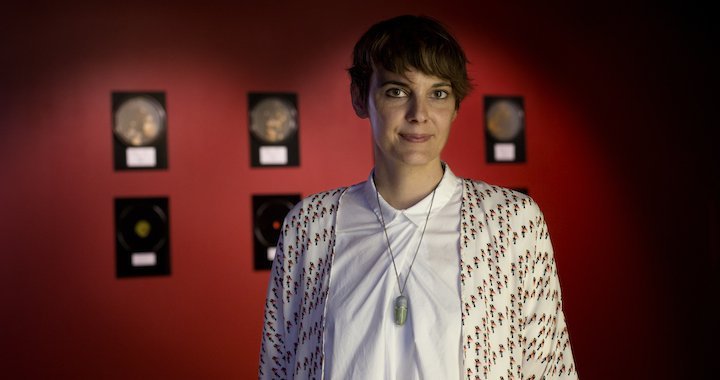
“We are only 10 percent human and 90 percent bacteria”
An interview with Amsterdam- and Vienna-based bio-artist Sonja Bäumel
31/07/2014
In Vienna they call her a bio-artist, whereas in Amsterdam she is presented as a designer. She doesn't apply either of these labels to herself.
I meet with Sonja Bäumel in Riga, at the art gallery “Alma”, where her work is part of the current exhibition “Molekulārās dzīves metamorfozes”/”Metamorphoses of Molecular Life”. Going on through August 15, the show features one of her bio-art-themed projects of 2012, “Expanded Self”, which takes a look at the bountiful bacterial populations that inhabit the top layer of our skin – much like an invisible universe.
Sonja arrived in Riga the previous day, and is very happy about how the show has been set up; she says that she put her complete trust into the hands of the show's curators – Lizete Riņķe and Elīna Sproģe. You may be surprised to hear that Bäumel spends a lot of her time in microbiology laboratories, but she is great at keeping things in check and knows when she has to take a step back and pause for a bit – so that she doesn't overload her mind with a torrent of scientific facts. This is necessary in order to preserve her creativity and vision.
This vision, however, is tethered down by the parallel world of bacteria. To the layperson, this hidden world is shrouded in myth, and to the scientific community, it is still surrounded by numerous question marks. Drawing on microbiologists claims that 90 percent of cells that constitute our body are not human, but bacterial (Brown, 2010) we can begin to envisage the human body as an ecosystem.
If one finds out too much about all this, there's a tendency to sit down and ponder the fact that we are actually nothing, but at the same time – part of something greater. Sonja has always been sure of this revelation, and that's why in her work, she poses questions and searches for answers that can bring us a greater understanding of our secretive body layer. She does this informative work through mediums that are understandable to all, and by using the skills that she acquired at the Vienna Fashion Institute, as well as the knowledge of conceptual design that she absorbed at the Eindhoven Design Academy.
Life has brought Sonja into contact with scientists that are completely engrossed with their field of study – people that are just as enthusiastic, and practically obsessed, with the world of bacteria as Sonja herself is.
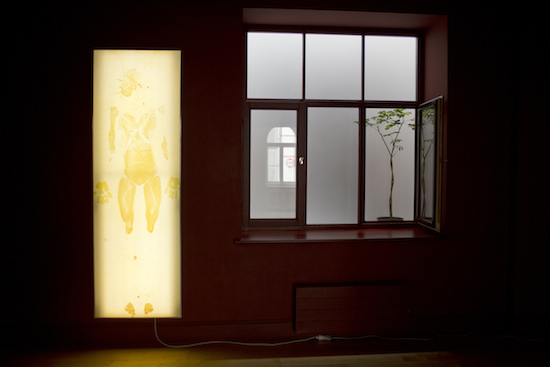
Sonja Bäumel's piece, “Expanded Self”, in the exhibition titled “Metamorpheses of Molecular Life”, currently on view at the gallery “Alma”. Photo: Kristīne Madjare
In order to create the piece currently on view in Riga, “Expanded Self”, Bäumel laid herself down on a human-sized Petri dish filled with cold agar (the 210 x 80 cm-large dish was specially created for the scientific film “Planet you”/”Wir sind Planeten”, 2012) – to inoculate the Petri dish with the bacteria living on her body. Bäumel's experiment was successful – after seven days, a visible image of growing bacteria could bee seen on the “canvas” of the agar. The living and growing picture of a body, was photographed and documented on the seventh day of growth. This imprint of a human body is a kind of metaphor for new points of view of our person.
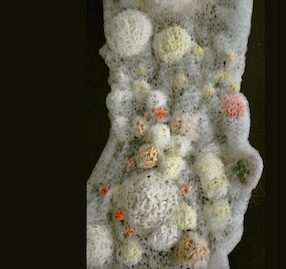

The Textured Self. 2011
Bäumel transforms these visual revelations of complex, scientific data into tactile and visual forms, as her unusual “textured self” project shows – spheres and strings of yarn portray the colors, volumes and structures of the bacterial populations found on our skin.
In her work, Bäumel raises issues related to how we can utilize this invisible world of bacteria and how we could find new ways of collaborating with the small creatures living on us. Consequently, her creations balance somewhere between art and science; between fashion, design and art; between clothing and the body; and between fact and fiction.
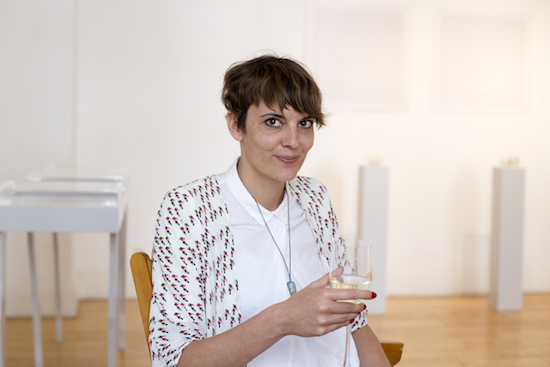
Photo: Kristīne Madjare
I take it that your works often require a specially adaptable environment for exhibition. What would your ideal exhibition, and the space it is set up in, look like?
First of all, it would be one in which I could exhibit anything that I want. Considering that I work with living materials, but exhibition spaces have certain limitations and safety regulations, that's not always possible. That's understandable, of course. My ideal exhibition space would be a greenhouse.
You studied fashion design and conceptual design. Were you aware of your interest in science back then already?
Actually, I've always been interested in biology. The most impressive gift that I remember from my childhood was a microscope. I tried to look at everything under its lens, including the bugs and insects that I collected at the time.
Later on, when I was working in fashion design, I often used insect shapes and motifs. But it all really started while I was studying for my master's in conceptual design at Eindhoven Design Academy. The Academy's program is very interdisciplinary, and within it I could realize my interest in the human body by linking it to art, fashion and design.
Would you say that fashion and design, in their classic senses, bored you?
I tried to look for a master's program that wouldn't be strictly tied to fashion or product design. Eindhoven offered a very open understanding of conceptual design. In my last year I started working with bacteria. I felt that I had to go down this road, and I received a positive, albeit very perplexed, reaction. Now I can say that my work encompasses various fields. I use design as a methodology to critically reflect. Fashion design serves as the biggest non-verbal platform between human interaction and as a medium for visualizing the discoveries I make in scientific laboratories.
So, you don't see yourself as an artist?
As for myself: I do not like, neither need to specifically “define” myself as an artist, a designer, a fashion designer, etc. I am simply passionate for what I am doing and researching within my creative practice; my projects’ outcomes are often interpreted in a different way by the audience itself, bringing them to define me as an artist in one city and/or a designer in another one. Starting my research process by being bound to a defining field/category that I should belong to (design, art, science, etc.), would not allow me to freely explore the subjects I entreat, and would therefore forbid me from allowing (unexpected) results to happen.
Clearly, it is totally fine that people categorize the projects once they’ve been realized.
However, I think we should generally start the creative process by following our individual motivations and interests, as that is where the greatest potential can be found.
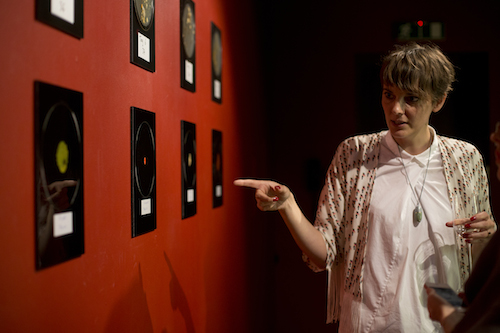
Photo: Kristīne Madjare
How do you manage to keep your creative vision throughout the daily onslaught of data and facts?
It's important to know when to take a break. If I sink too deeply into the scientific world – with all of its facts – my creativity can be hindered. One must keep a balance. Sometimes it's important to step back from everything I've learned and discovered in the lab, so that I can set my imagination free.
Could you describe the structure of how you work – the guidelines you set, the laboratory processes, and at what point does the work's visual form begin to manifest?
I submitted my master's thesis in 2009. Since then I've been following its vision in my head, but somehow it's turned out that I can't see it ever ending. There is a sort of structure in my work, but it's very open. I'm captivated by the research as such; I like to document and analyze. Of course, I follow through with and “finish" my projects, but each one is actually “just” one more step in an ongoing process; it never comes to an end. You see, the working process is much more crucial than the end result.
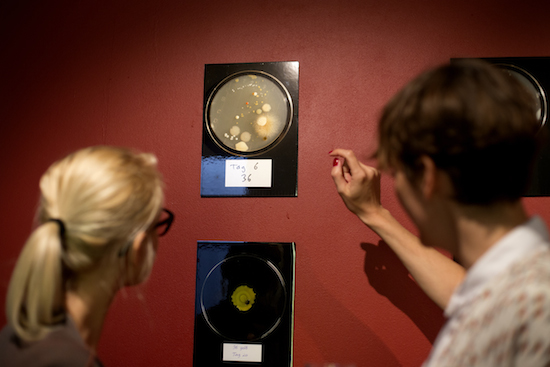
Photo: Kristīne Madjare
What's going on in the lab right now?
My newest piece was created at the Ars Electronica Center's Future- and Biolab artist in residency program in Linz, where I worked together with a scientist, Manuel Selg, on my project Metabodies. It was a fantastic experience that lasted for four weeks. Metabodies can be regarded as an interim update of ongoing research, and is still on display in the Ars Electronica Center’s exhibition “Project Genesis”.
From Sonja Bäumel's work, “Metabodies” (2013), done in cooperation with the scientist Manuel Selg. Pictured: The palm of a woman's hand, after running; The palm of a man's hand, after taking a shower; The palm of a woman's hand, after having had sex.
The project done at the Ars Electronica Center's Future- and Biolab, “Metabodies”, was a big challenge. The proposed objective was to observe how bacteria communicate with each other in various contexts such as, for instance, an emotional one. It's a very complex process, but exciting – in learning about this, we could perhaps have a better notion of how our bodies communicate and interact with the surrounding environment.
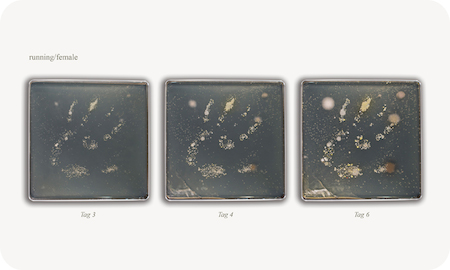
Metabodies (2013). Woman's palm imprints after a sporting activity
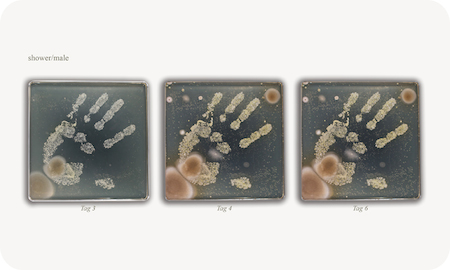
Man's palm imprints after taking a shower
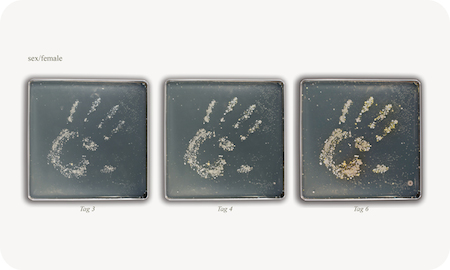
Woman's palm imprints after having sex
In the experiment, we did the research with two subjects who had to give us their palm imprints after a sporting activity, after having sex, and after taking a shower. Questions such as: Could we be able to observe the language bacteria ‘speak’ through molecules, in different conditions? How does this communication change in different contexts?
It is interesting that in all of our activities, we differ from one another not only genetically but also bacterially.
Do you think that your discoveries could be realistically used in fashion design?
In my ‘(in)visible’ film (2008), I envisioned how a novel second skin layer, involving organisms such as existing skin bacteria and slime mold, could mutate when adapting to different environments and contexts. Through such work and vision, I asked questions related to the way the interaction between humans and the environment could change when triggered by the adaptive capacity of this new individual layer on our skin. I imagined what would happen if our second skin would be considered something different from the way it is nowadays; fashion is, in fact, what currently defines such a layer. However, the fashion system is strongly based and built upon the opinion and dictation of some specific minds who decide, through practices like ‘trend forecasting’, what is good and what is not. On the contrary, I strongly believe that such a second skin could be much more meaningful and authentic when based on one’s individual biological identity, environmental conditions and social needs.
Cultural imagination about scientific facts is a very important skill to cultivate, aiming to involve different audiences (designers, architects, creatives, scientists, the general public, etc.) into deeply thinking and reflecting, while dreaming, wondering and exploring the world we are all a part of. Promoting the understanding of the fact that we are all somehow connected through an invisible biological network that is present on our skin, is an essential concept rooted in my work. I personally feel that there is a strong need of promoting and fostering imaginative practices: we need imagination to help us question existing facts and to envision where our current knowledge could lead us in the upcoming future, both positively and negatively.
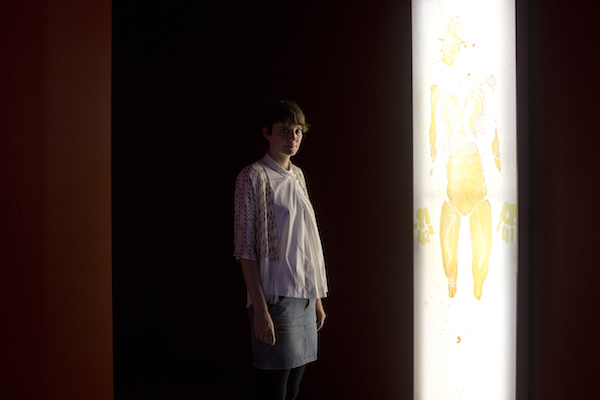
Photo: Kristīne Madjare
So, through your work, you wish to change how people view their bodies and the bacterial world that is an indivisible part of it?
I am interested in outlining a “bigger picture”, and particularly in understanding in which way we, humans, are connected to our surroundings and enveloped within an unknown network, which could perhaps lead us to identify new forms of possible interaction between us and with the environment. Furthermore, my interest lies in what influences scientific knowledge in regards to the way we have historically perceived and interpreted the human body, with the objective of transferring such understanding within contemporary time and projecting it further into the future, aiming to unravel in which way our comprehension of the biological body affects our current society and the related cultural context.
How has your relationship to your own body changed since you started your research?
Well... I still take showers (laughs).
My work has allowed me to gain a much larger understanding. To be capable of fully integrating with natural life-systems, we firstly need to re-start considering and respecting microbes and tiny creatures as equal partners. Such behavioral change could allow us to start learning from them and their expertise, derived from billions of years of existence. Microorganisms adapted to radical changes and transformations in an incredibly successful way, and accordingly, they were capable of evolving in relation to the resulting novel needs. We could learn a lot from this.
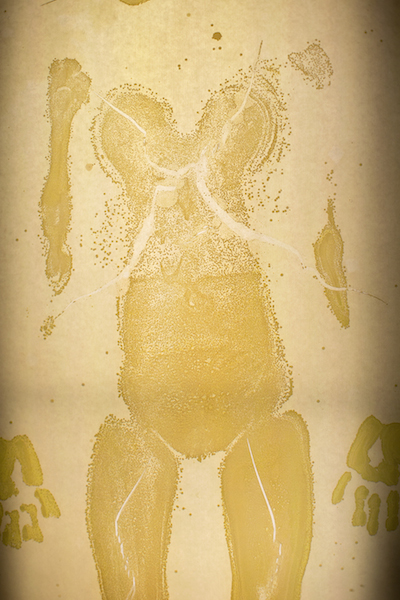
Expanded Self. 2012. Photo: Kristīne Madjare
Involvement in educational work, for instance, with school children and students, is important...
I lecture and lead workshops in various international institutions and educational centers, such as the University of Applied Arts Vienna, the Shih Chien University Taipei, etc. Furthermore, I currently teach at the Gerrit Rietveld Academie in Amsterdam.